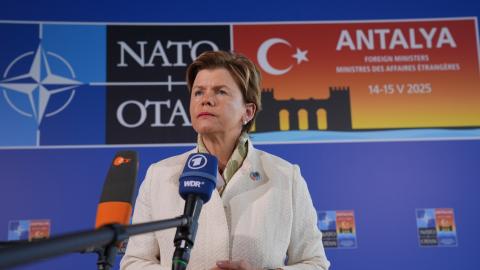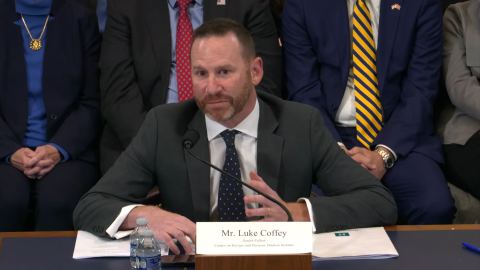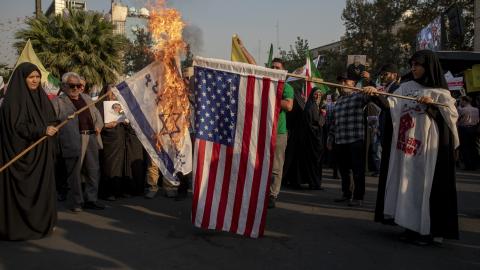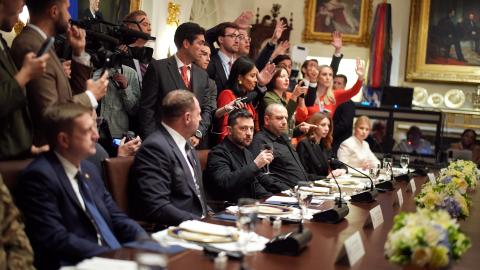Russian Jewish novelist Vasily Grosman, who was the first journalist to see the Nazi death camp Treblinka, once wrote, “Anti-Semitism is … a mirror for the failings of individuals, social structures and State systems. Tell me what you accuse the Jews of — I’ll tell you what you’re guilty of.” In On Democracies and Death Cults, Douglas Murray’s new book on the stakes and strategy of the conflict that began with the Oct. 7, 2023, attack on Israel, Murray notes that this applies neatly to the terrorists, whose leaders accuse Israel of targeting Palestinian children in one breath and in the next say, “Children are tools to be used against Israel. We will sacrifice them for the political support of the world.”
“Sometimes a flare goes up and you get to see exactly where everyone is standing,” Murray notes. “The morning of October 7, 2023, was just such a moment.” Hamas death squads and other Gazans overwhelmed Israeli border defenses, then looted, raped, and murdered until they were thrown back, dragging about 250 hostages with them. Even before the Israelis had fully repulsed the attack, hundreds of degenerates filled Times Square to cheer on the carnage. Murray photographed one woman there as “she punched the air and screamed with joy.” Others held up signs reading, “By Any Means Necessary” while Israelis were still being tortured and murdered. Copycat celebrations popped up across the West. Shortly thereafter, Murray boarded a plane for Israel.
This book is being released at a hinge moment in the conflict, and the world’s perception of it. The Israeli military is returning to Gaza after the breakdown of a flimsy ceasefire to finally extinguish Hamas and attempt to free any remaining living hostages — if it can, and if Israeli political will holds. Starting back in 2023, Murray interviewed survivors and the victims’ family members, visited the sites of the massacres, and even spoke with some of the butchers whom the Israelis captured. Firsthand reporting is crucial, he knew, because one of the recurring features of antisemitism is that Jew haters celebrate the atrocities they commit, often openly, then deny that they ever happened.
That section makes for grim reading. Many of the victims died in their own homes, often in the safe rooms built to protect them from rocket and mortar barrages from Gaza. As one survivor put it, when the Gazans arrived to break into the safe rooms, “if you couldn’t hold the door [closed], you’re not with us.” Many homes had “blood-covered handprints and nail and finger marks” from desperate civilians who tried to prevent their tormentors from dragging them out. In one bomb shelter, “the blood splatter” on the ceiling “suggested that some of the victims were finished off with machetes.”
This was all part of a plan. Since the Iranian revolution in 1979, Iran has armed and equipped terrorist organizations across the Middle East to further its imperial ambitions and destroy Israel. Hamas, the principal author of the Oct. 7 attacks, issued detailed instructions to its killers about, “how many kibbutz members they were allowed to kill, in what manner, who they were permitted to rape, what to do with an IDF soldier’s body, and more.” It also planned with Iran’s Lebanese lackeys, Hezbollah, to attack Israel from the south and then the north, overrunning the Jewish state and meeting in the middle. Despite being better armed than Hamas, Hezbollah restricted itself to bombarding Israel until the Israeli government pulled off a daring series of attacks that annihilated Hezbollah’s leadership and much of its rank and file.
Just as the mass murder of Israelis drew cheers in many parts of the world, Israel drew scorn for fighting back. Murray shreds many of the most common anti-Israel talking points: unlike in Gaza after 2005, which Israel allegedly turned into a concentration camp by withdrawing from it, “there was no population boom in Auschwitz in the 1940s.” On Israel’s “disproportionate” response? “As it happens, there is no law of war that says you can start a war and then complain when you begin to lose.” He points out that “apartheid” better describes the living conditions of the remaining Jews in Arab countries than it does those of Israeli Arabs.
How Hamas Invented a New War Crime
But that doesn’t explain Western support for Hamas. Unlike Hamas, Western democracies do not hide weapons under cribs or position gunmen directly under the wheelchairs of the elderly. But as Murray observes, “A generation has come up that has been taught that by dint of being born into the West, they have been born into countries built on ethnic cleansing and genocide, founded by people who are settler-colonialist racists, and that their societies perpetuate these evils right to this very day.” Perhaps Grossman should be amended, “Tell me what you accuse the Jews of — I’ll tell you what you believe you are guilty of.” In other words, many Westerners hate Israel because it reflects the often imaginary parts of their own societies that they despise.
But in laying out the reality of a conflict that is between worshippers of death vs. protectors of life, Murray has shown that one of the great controversies of the world is in fact quite simple. It is only by being removed from the factual and emotional realities of the situation, and the region, that so many of us get it so grossly backward.

















